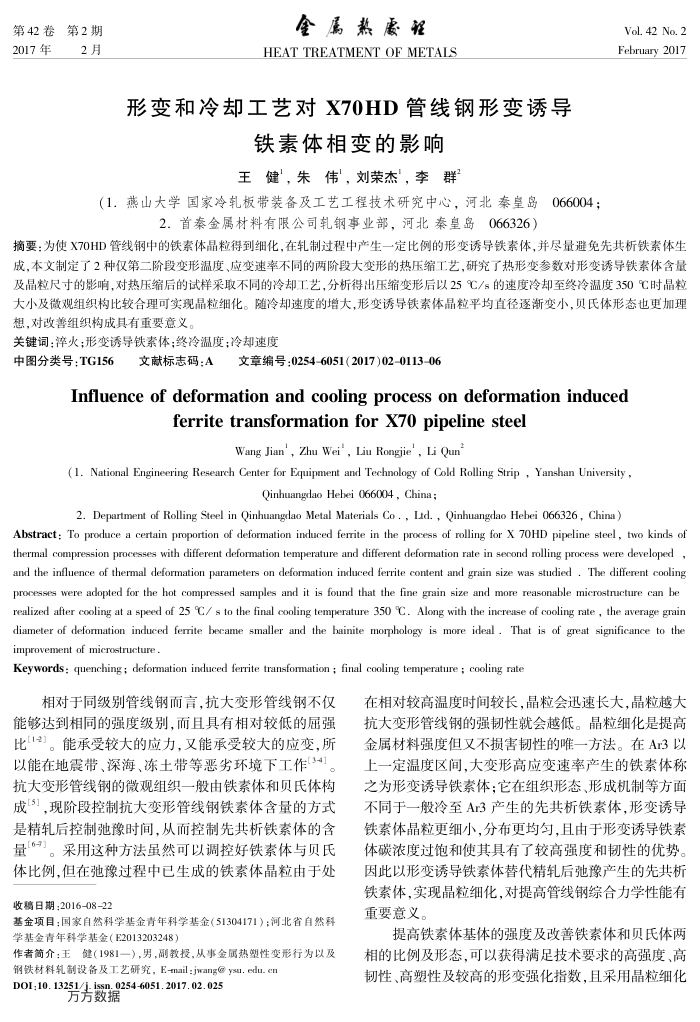形变和冷却工艺对X70HD管线钢形变诱导铁素体相变的影响
内容简介
 第42卷第2期 2017年2月
第42卷第2期 2017年2月金属热广程 HEAT TREATMENT OF METALS
形变和冷却工艺对X70HD管线钢形变诱导
铁素体相变的影响王健,朱伟,刘荣杰,李群
(1.燕山大学国家冷轧板带装备及工艺工程技术研究中心,河北秦皇岛066004;
2.首秦金属材料有限公司轧钢事业部,河北秦皇岛066326)
Vol. 42 No. 2 February 2017
摘要:为使X70HD管线钢中的铁素体晶粒得到细化,在轧制过程中产生一定比例的形变诱导铁素体,并尽量避免先共析铁素体生成,本文制定了2种仅第二阶段变形温度、应变速率不同的两阶段大变形的热压缩工艺,研究了热形变参数对形变诱导铁素体含量及晶粒尺寸的影响,对热压缩后的试样采取不同的冷却工艺,分析得出压缩变形后以25℃/s的速度冷却至终冷温度350℃时晶粒大小及微观组织构比较合理可实现晶粒细化。随冷却速度的增大,形变诱导铁素体晶粒平均直径逐渐变小,贝氏体形态也更加理想,对改善组织构成具有重要意义。
关键词:率火;形变诱导铁素体;终冷温度;冷却速度
中图分类号:TG156文献标志码:A文章编号:0254-6051(2017)02-0113-06
Influenceofdeformationandcoolingprocessondeformationinduced
ferritetransformationforX70pipeline steel
Wang Jian', Zhu Wei', Liu Rongjie', Li Qun
(1. National Engineering Research Center for Equipment and Technology of Cold Rolling Strip , Yanshan University ,
Qinhuangdao Hebei 066004 , China ;
2. Department of Rolling Steel in Qinhuangdao Metal Materials Co . , Lid. , Qinhuangdao Hebei 066326, China)
Abstract : To produce a certain proportion of deformation induced ferrite in the process of rolling for X 70HD pipeline steel, two kinds of thermal compression processes with different deformation temperature and different deformation rate in second rolling process were developed and the influence of thermal deformation parameters on deformation induced ferrite content and grain size was studied . The different cooling processes were adopted for the hot compressed samples and it is found that the fine grain size and more reasonable microstructure can be realized after cooling at a speed of 25 °C / s to the final cooling temperature 350 °C. Along with the increase of cooling rate , the average grain diameter of deformation induced ferrite became smaller and the bainite morphology is more ideal . That is of great significance to the improvement of microstructure .
Keywords: quenching; deformation induced ferrite transformation ; final cooling temperature ; cooling rate
相对于同级别管线钢而言,抗大变形管线钢不仅
能够达到相同的强度级别,而且具有相对较低的屈强比1。能承受较大的应力,又能承受较大的应变,所以能在地震带、深海、冻土带等恶劣环境下工作[34]。抗大变形管线钢的微观组织一般由铁素体和贝氏体构成[3],现阶段控制抗大变形管线钢铁素体含量的方式是精轧后控制弛豫时间,从而控制先共析铁素体的含量。采用这种方法虽然可以调控好铁素体与贝氏体比例,但在弛豫过程中已生成的铁素体晶粒由于处
收稿日期:2016-08-22
基金项目:国家自然科学基金青年科学基金(51304171);河北省自然科学基金青年料学基金(E2013203248)
作者简介:王健(1981一),男,副教授,从事金属热塑性变形行为以及
钢铁材料轧制设备及工艺研究,E-mail:jwang@ysul.edu.en DOI:10. 13251/_ issn. 0254-6051. 2017. 02. 025
万方数据
在相对较高温度时间较长,晶粒会迅速长大,晶粒越大抗大变形管线钢的强韧性就会越低。晶粒细化是提高金属材料强度但文不损害韧性的唯一方法。在Ar3以上一定温度区间,大变形高应变速率产生的铁素体称之为形变诱导铁素体;它在组织形态、形成机制等方面不同于一般冷至Ar3产生的先共析铁系体,形变诱导铁素体晶粒更细小,分布更均匀且由于形变诱导铁素体碳浓度过饱和使其具有了较高强度和韧性的优势。因此以形变诱导铁素体替代精轧后弛豫产生的先共析铁素体,实现晶粒细化,对提高管线钢综合力学性能有重要意义。
提高铁素体基体的强度及改善铁素体和贝氏体两相的比例及形态,可以获得满足技术要求的高强度、高韧性、高塑性及较高的形变强化指数,且采用晶粒细化